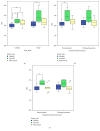Brain Symmetry Index in Healthy and Stroke Patients for Assessment and Prognosis
- PMID: 28251015
- PMCID: PMC5304313
- DOI: 10.1155/2017/8276136
Brain Symmetry Index in Healthy and Stroke Patients for Assessment and Prognosis
Abstract
Objective. Quantitative neurophysiological signal parameters are of value in predicting motor recovery after stroke. The novel role of EEG-derived brain symmetry index for motor function prognostication in the subacute phase after stroke is explored. Methods. Ten male stroke patients and ten matched healthy controls were recruited. Motor function was first assessed clinically using the MRC score, its derivative Motricity Index, and the Fugl-Meyer assessment score. EEG was subsequently recorded first with subjects at rest and then during hand grasping motions, triggered by visual cues. Brain symmetry index (BSI) was used to identify the differences in EEG-quantified interhemispheric cortical power asymmetry observable in healthy versus cortical and subcortical stroke patients. Subsequently, any correlation between BSI and motor function was explored. Results. BSI was found to be significantly higher in stroke subjects compared to healthy controls (p = 0.023). The difference in BSI was more pronounced in the cortical stroke subgroup (p = 0.016). BSI showed only a mild general decrease on repeated monthly recording. Notably, a statistically significant correlation was observed between early BSI and Fugl-Meyer score later in recovery (p < 0.050). Conclusions. Brain symmetry index is increased in the subacute poststroke phase and correlates with motor function 1-2 months after stroke.
Conflict of interest statement
None of the authors have potential conflict of interests to be disclosed.
Figures






References
-
- Mackay J., Mensah G. The Atlas of Heart Disease and Stroke. World Health Organization (WHO), http://www.who.int/cardiovascular_diseases/resources/atlas/en/
-
- Fugl Meyer A. R., Jaasko L., Leyman I. The post stroke hemiplegic patient. I. A method for evaluation of physical performance. Scandinavian Journal of Rehabilitation Medicine. 1975;7(1):13–31. - PubMed
LinkOut - more resources
Full Text Sources
Other Literature Sources
Medical

